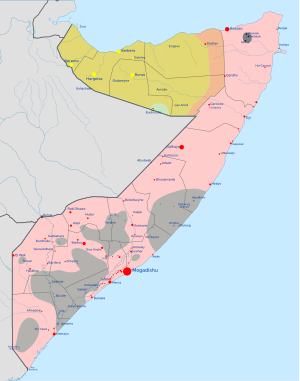Somali Civil War (2009–present) facts for kids
Quick facts for kids Somali Civil War (2009–present) |
|||||||
|---|---|---|---|---|---|---|---|
| Part of the Somali Civil War and the war on terror | |||||||
 Military situation in Somalia as of March 2023
Under control of the Somali government and allies Under control of al-Shabaab Under control of the Islamic State Under control of the Khatumo State Under control of the self-declared state of Somaliland Disputed territory between the government of Somaliland and the Puntland State of Somalia |
|||||||
|
|||||||
| Belligerents | |||||||
|
|
Regional forces:
Supported by: |
||||||
| Commanders and leaders | |||||||
|
Casualties:
|
|
||||||
| Strength | |||||||
|
|
|||||||
| Casualties and losses | |||||||
23,377 killed 1,884 killed 3 killed, 2 contractors killed 5 wounded |
|||||||
|
4,365 killed (in 2015) Jan 2009 – Oct 2012: |
|||||||
The Somali Civil War is a conflict that has been happening in Somalia since 2009. It is mainly a fight between the al-Shabaab group and the Somali government. This war mostly takes place in southern and central Somalia, and also in parts of northeastern Kenya.
The conflict started in February 2009. The Federal Government of Somalia was supported by African Union peacekeeping troops. At first, al-Shabaab gained a lot of ground. They even took over Baidoa, which was a temporary capital for the government. Al-Shabaab continued fighting the government and the African Union forces throughout 2010. They became very strong in many areas. People in these areas sometimes supported al-Shabaab because they brought a system of law and order.
Contents
Key Events in the Conflict
Kenya's Involvement and Al-Shabaab's Challenges
In October 2011, Kenya sent its military into southern Somalia. This was called Operation Linda Nchi. The Kenyan government was worried about many refugees coming into Kenya. They also wanted to stop the conflict from spreading across their border.
The Kenyan forces joined the Somali government and African Union troops. This put a lot of pressure on al-Shabaab. They were pushed out of Kismayo, an important port city. Somalia also faced a very bad famine in 2011, which made things even harder for al-Shabaab.
Al-Shabaab's Ongoing Influence
Even with these challenges, al-Shabaab still controls large areas in southern Somalia. They are still powerful in many rural places. Now, they often use surprise attacks and terror tactics instead of trying to take over more land. Other groups, like the Islamic State in Somalia (ISS) and Hizbul Islam, have also attacked both sides. Hizbul Islam stopped fighting the government in 2013. However, ISS is still active in northern Somalia as of 2022.
International Support for Somalia
Many countries and organizations have helped Somalia. They want to bring peace and stability to the country.
African Union's Role
The African Union has sent more than 16,000 soldiers to Somalia. This mission is now called the ATMIS (before 2022, it was AMISOM). Their job is to support the Somali government. They also help train Somali soldiers and create a safe environment. This safe environment helps get humanitarian aid to people who need it.
United States and Other Countries' Aid
The United Nations Development Programme (UNDP) helps Somalia with about $50 million each year. This money is not for military help. Instead, it supports programs like creating jobs for people recovering from the conflict.
The United States has also given a lot of money to support the African Union mission. In 2013, the U.S. officially started working with Somalia's central government again after 20 years. This decision was made because Somalia had made good progress. This helped Somalia get more money for rebuilding from American groups and international organizations like the International Monetary Fund and World Bank.
About 50 U.S. special forces troops also work in Somalia. They help and advise Kenyan, Somali, and Ugandan forces fighting al-Shabaab. The United Kingdom also has special forces helping to fight against terrorist groups in Somalia.
In December 2020, President Donald Trump ordered most U.S. troops to leave Somalia. But in May 2022, President Joe Biden changed this decision. He sent up to 450 ground troops back to Somalia.
Images for kids
See also
 In Spanish: Segunda guerra civil somalí para niños
In Spanish: Segunda guerra civil somalí para niños






